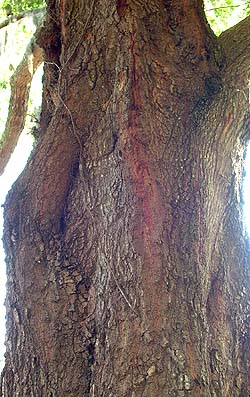Home > Health and maintenance > Solve problems > Trunk bugles
Trunk bulges
 Bulges
in the trunk can be caused by a variety of factors including the tree's reaction
to an irritation such as a bacterium, a tree's reaction to a defect such as
hollow decayed spot or a crack, or reaction to a pruning cut. The bulge indicates
an increase in the rate of wood growth in that localized area. Trees attempt
to strengthen a weak portion of the trunk or branch by generating more wood
near a weak area.
Bulges
in the trunk can be caused by a variety of factors including the tree's reaction
to an irritation such as a bacterium, a tree's reaction to a defect such as
hollow decayed spot or a crack, or reaction to a pruning cut. The bulge indicates
an increase in the rate of wood growth in that localized area. Trees attempt
to strengthen a weak portion of the trunk or branch by generating more wood
near a weak area.
There is little that can be done for the bulge but the bulge represents a warning signal about a potential defect inside. Have an arborist evaluate the tree. Nothing may need to be done at all if the defect is judged to be small, or if there is no target that could be injured or damaged nearby. Measures such as moving a target that could be impacted by a falling branch or tree might be advised if the defect is judged a problem (click to see photo). An arborist might also recommend a pruning or cabling and bracing solution.

Inclusions or creases in the lower trunk are normal for certain trees such as laurel oaks (click to see photos). This results from parts of the cambium growing faster than other parts. Wood on either side of these inclusions can become injured as the tree grows older; the wood can injure itself as the tree moves in the wind. Inclusions in the lower trunk are not common in live oaks.
Some trees produce an exaggerated root flare extending well above the soil. Root flares often become more exaggerated on trees growing in soils with poor drainage than on trees growing in well-drained soil. These are normal and nothing needs to done. They function in holding the tree up.

